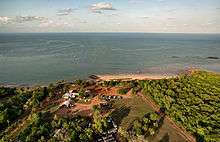Dundee, Northern Territory
| Dundee Northern Territory | |
|---|---|
 Dundee | |
| Coordinates | 12°49′S 130°27′E / 12.817°S 130.450°ECoordinates: 12°49′S 130°27′E / 12.817°S 130.450°E |
| Population | 400 (est.)[1] |
| Postcode(s) | 0840 |
| Location | 125 km (78 mi) SW of Darwin |
| LGA(s) | Unincorporated Top End Region |
| Territory electorate(s) | Daly |
| Federal Division(s) | Lingiari |
Dundee is a town in the Northern Territory, Australia, located approximately 125 km (78 mi) southwest of Darwin on a peninsula between the Timor Sea and Bynoe Harbour. Dundee consists of three separate localities: Dundee Beach on the Timor Sea, Dundee Forest in the central peninsula and Dundee Downs adjacent to Bynoe Harbour in the east. The localities are named after the original subdivisions, believed to be in reference to the film "Crocodile" Dundee.[2] The permanent population is estimated at approximately 400 residents.[1]
Development in the area began in the 1990s, originally as a weekend retreat for Darwin residents. The local economy is still largely dependent on tourism, with fishing being the main attraction. Community services and amenities include a small school established in 1998,[3] a volunteer fire brigade and several sporting and social clubs.
The town is situated in an unincorporated area with no local government; however, the possibility of Dundee's being included in an expanded Coomalie Shire has been raised in recent times. Currently, a volunteer progress association represents the interests of Dundee residents to the Northern Territory Government.[4]
Swivel gun discovery
One of Australia's earliest artifacts of European origin was found by a 13-year-old school boy on Dundee Beach in 2010. Initially believed to be a Portuguese Swivel gun dating from the 1500s,[5] the discovery prompted international media attention and renewed speculation about early Portuguese exploration of Australia prior to the arrival of Captain Cook on the East Coast in 1770.[6] However this claim has been disputed by the Museum and Art Gallery of the Northern Territory following analysis of sand inside the gun's barrel dating it closer to 1750. The museum instead speculated it was likely dropped overboard by Makassan traders who were known to visit the area to harvest Sea cucumber and trade with local Aboriginal peoples.[7] This indicates the gun was more likely a copy of a Dutch or Portuguese design, manufactured in South East Asia.
References
- 1 2 http://www.cgc.gov.au/attachments/article/114/NT%20-%202006-09-S%20response.rtf.
- ↑ NT Place Names
- ↑ McLaughlin, Murray (24 February 2010). "A Tale of two schools". Australian Broadcasting Corporation.
- ↑ Dundee Progress Association
- ↑ La Canna, Xavier (23 May 2014). "Should Dundee cannon be protected?". Australian Broadcasting Corporation.
- ↑ Dean, Sarah (24 May 2014). "Did Portuguese beat Captain Cook to Australia by 250 years?". Daily Mail.
- ↑ La Canna, Xavier (22 May 2014). "Old cannon found in NT dates to 1750s". Australian Broadcasting Corporation.
